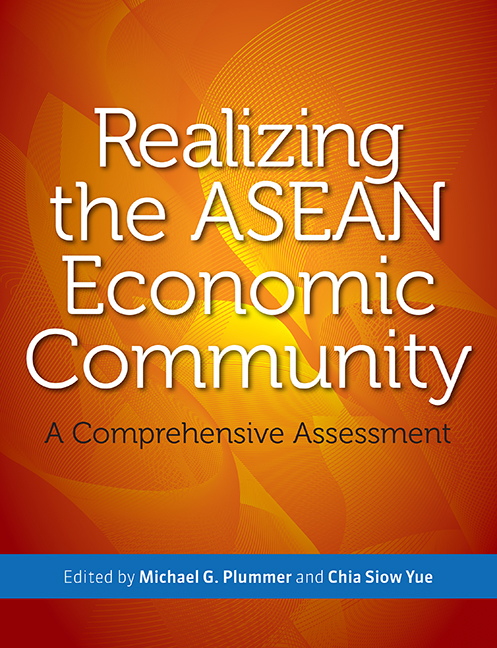Book contents
- Frontmatter
- Contents
- Illustrations
- Foreword
- Executive Summary
- Acknowledgements
- About the Contributors
- 1 Introduction
- 2 Regional Market for Goods, Services, and Skilled Labor
- 3 Competition Policy, Infrastructure, and Intellectual Property Rights
- 4 The AEC and Investment and Capital Flows
- 5 Narrowing the Development Gap in ASEAN
- 6 Competitiveness and Leverage
- 7 Benefits of the AEC
- References
- Appendix A AEC Components
- Appendix B The CGE Model
- Appendix C Developments in Logistics and Aviation
- Appendix D AEC Blueprint Excerpt
- Appendix E ASEAN Free Trade Agreements
- Appendix F ASEAN Member States' Free Trade Agreements
- Appendix G ASEAN Imports and Exports, 2000 and 2006
- Index
Appendix A - AEC Components
Published online by Cambridge University Press: 21 October 2015
- Frontmatter
- Contents
- Illustrations
- Foreword
- Executive Summary
- Acknowledgements
- About the Contributors
- 1 Introduction
- 2 Regional Market for Goods, Services, and Skilled Labor
- 3 Competition Policy, Infrastructure, and Intellectual Property Rights
- 4 The AEC and Investment and Capital Flows
- 5 Narrowing the Development Gap in ASEAN
- 6 Competitiveness and Leverage
- 7 Benefits of the AEC
- References
- Appendix A AEC Components
- Appendix B The CGE Model
- Appendix C Developments in Logistics and Aviation
- Appendix D AEC Blueprint Excerpt
- Appendix E ASEAN Free Trade Agreements
- Appendix F ASEAN Member States' Free Trade Agreements
- Appendix G ASEAN Imports and Exports, 2000 and 2006
- Index
Summary
In November 2002, the ASEAN Heads of Government meeting in Phnom Penh proposed that the region consider establishing an ASEAN Economic Community (AEC) by 2020. The ASEAN leaders agreed at the Bali ASEAN Summit in October 2003 to create a region in which goods, services, and skilled labor would flow freely, and capital would enjoy freer movement. In the 2007 Cebu Declaration the ASEAN leaders pushed the AEC deadline forward to 2015. In November 2007, the region approved the AEC Blueprint, which puts flesh to the bones of the commitment to create a unified market. The Blueprint was accompanied by a strategic schedule for implementing various measures. As part of this process, ASEAN developed the ASEAN Charter, which will significantly enhance the formal nature of ASEAN integration by making it an international legal entity. The Charter was signed on November 20, 2007 and went into effect after being ratified by all ASEAN Member States on December 15, 2008.
The AEC Blueprint has four parts:
1. Single Market and Production Base
• Free flow of goods, including the elimination of tariffs and nontariff barriers (NTBs), rules of origin harmonization and rationalization, trade facilitation, customs integration (including the ASEAN Single Window), and standards and technical barriers to trade (including mutual- recognition arrangements, or MRAs). Trade in goods receives the most attention, in part because it includes areas relevant to the entire AEC project (such as customs and other areas of trade facilitation).
• Free flow of services through a progressive increase in sectoral coverage, a commitment to advance mutual recognition of professional qualifications and services, and financial services liberalization through an ASEAN-X formula (i.e., an allowance for more advanced countries to proceed first).
• Free flow of investment, particularly FDI, building on the process initiated by the ASEAN Investment Area (AIA). The AEC will integrate several agreements pertinent to FDI, such as investment protection, and emphasize the cornerstones of the AIA (i.e., national treatment, investment facilitation and cooperation, and promotion).
- Type
- Chapter
- Information
- Realizing the ASEAN Economic CommunityA Comprehensive Assessment, pp. 187 - 192Publisher: ISEAS–Yusof Ishak InstitutePrint publication year: 2009



